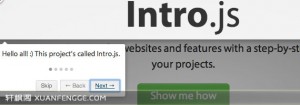前言
最近在折腾jQuery插件,写成插件的目的就是为了实现功能与项目相分离,使得这个代码在下一个项目中能直接引用不出错。这使得我们在写插件的时候,就得考虑清楚,怎么写才能使得插件能够通用、灵活度高、可配置、兼容性好、易用性高、耦合度低等。
接下来就对以下几种写法进行分析,前两个是jQuery插件,后面2个是以对象的形式开发,都类似。而且写法也很多,我们要懂得这样写的利弊。另一篇基础文章:jQuery 插件写法
写法一
插件主体
|
1 2 3 4 5 6 7 8 9 10 11 12 13 14 15 16 17 18 19 20 21 22 23 24 25 26 27 28 29 30 31 32 33 34 35 36 37 38 39 40 41 42 43 44 45 46 47 48 49 50 51 52 53 54 55 56 57 58 59 60 61 62 63 64 65 66 67 68 69 70 71 72 73 74 75 76 77 78 |
(function($, window){ // 初始态定义 var _oDialogCollections = {}; // 插件定义 $.fn.MNDialog = function (_aoConfig) { // 默认参数,可被重写 var defaults = { // string sId : "", // num nWidth : 400, // bollean bDisplayHeader : true, // object oContentHtml : "", // function fCloseCallback : null }; var _oSelf = this, $this = $(this); // 插件配置 this.oConfig = $.extend(defaults, _aoConfig); // 初始化函数 var _init = function () { if (_oDialogCollections) { // 对于已初始化的处理 // 如果此时已经存在弹框,则remove掉再添加新的弹框 } // 初始化弹出框数据 _initData(); // 事件绑定 _loadEvent(); // 加载内容 _loadContent(); } // 私有函数 var _initData = function () {}; var _loadEvent = function () {}; var _loadContent = function () { // 内容(分字符和函数两种,字符为静态模板,函数为异步请求后组装的模板,会延迟,所以特殊处理) if($.isFunction(_oSelf.oConfig.oContentHtml)) { _oSelf.oConfig.oContentHtml.call(_oSelf, function(oCallbackHtml) { // 便于传带参函数进来并且执行 _oSelf.html(oCallbackHtml); // 有回调函数则执行 _oSelf.oConfig.fLoadedCallback && _oSelf.oConfig.fLoadedCallback.call(_oSelf, _oSelf._oContainer$); }); } else if ($.type(_oSelf.oConfig.oContentHtml) === "string") { _oSelf.html(_oSelf.oConfig.oContentHtml); _oSelf.oConfig.fLoadedCallback && _oSelf.oConfig.fLoadedCallback.call(_oSelf, _oSelf._oContainer$); } else { console.log("弹出框的内容格式不对,应为function或者string。"); } }; // 内部使用参数 var _oEventAlias = { click : 'D_ck', dblclick : 'D_dbl' }; // 提供外部函数 this.close = function () { _close(); } // 启动插件 _init(); // 链式调用 return this; }; // 插件结束 })(jQuery, window); |
调用
|
1 2 3 4 5 6 7 8 9 10 11 12 13 |
var MNDialog = $("#header").MNDialog({ sId : "#footer", //覆盖默认值 fCloseCallback : dialog,//回调函数 oContentHtml : function(_aoCallback){ _aoCallback(_oEditGrpDlgView.el); } } }); // 调用提供的函数 MNDialog.close; function dialog(){ } |
点评
1. 自调用匿名函数
|
1 2 3 |
(function($, window) { // jquery code })(jQuery, window); |
用处:通过定义一个匿名函数,创建了一个“私有”的命名空间,该命名空间的变量和方法,不会破坏全局的命名空间。这点非常有用也是一个JS框架必须支持的功能,jQuery被应用在成千上万的JavaScript程序中,必须确保jQuery创建的变量不能和导入他的程序所使用的变量发生冲突。
2. 匿名函数为什么要传入window
通过传入window变量,使得window由全局变量变为局部变量,当在jQuery代码块中访问window时,不需要将作用域链回退到顶层作用域,这样可以更快的访问window;这还不是关键所在,更重要的是,将window作为参数传入,可以在压缩代码时进行优化,看看jquery.min.js:
|
1 |
(function(a,b){})(jQuery, window); // jQuery被优化为a, window 被优化为 b |
3. 全局变量this定义
|
1 2 |
var _oSelf = this, $this = $(this); |
使得在插件的函数内可以使用指向插件的this
4. 插件配置
|
1 |
this.oConfig = $.extend(defaults, _aoConfig); |
设置默认参数,同时也可以再插件定义时传入参数覆盖默认值
5. 初始化函数
一般的插件会有init初始化函数并在插件的尾部初始化
6. 私有函数、公有函数
私有函数:插件内使用,函数名使用”_”作为前缀标识
共有函数:可在插件外使用,函数名使用”this.”作为前缀标识,作为插件的一个方法供外部使用
7. return this
最后返回jQuery对象,便于jQuery的链式操作
写法二
主体结构
|
1 2 3 4 5 6 7 8 9 10 11 12 13 14 15 16 17 18 19 20 21 22 23 24 25 26 27 28 |
(function($){ $.fn.addrInput = function(_aoOptions){ var _oSelf = this; _oSelf.sVersion = 'version-1.0.0'; _oSelf.oConfig = { nInputLimitNum : 9 }; // 插件配置 $.extend(_oSelf.oConfig, _aoOptions); // 调用这个对象的方法,传递this $.fn.addrInput._initUI.call(_oSelf, event); $.fn.addrInput._initEvents.call(_oSelf); // 提供外部函数 this.close = function () { _close(); } //返回jQuery对象,便于Jquery的链式操作 return _oSelf; } $.fn.addrInput._initUI = function(event){ var _oSelf = this, _oTarget = $(event.currentTarget); } $.fn.addrInput._initEvents = function(){} })(window.jQuery); |
点评
1. 美观
插件的方法写在外部,并通过在插件主体传递this的方式调用
2. 定义插件版本号
不过在这里还是没有用到
3. 关于call
这里的第一个参数为传递this,后面的均为参数
语法:
|
1 |
call([thisObj[,arg1[, arg2[, [,.argN]]]]]) |
定义:调用一个对象的一个方法,以另一个对象替换当前对象。
说明:call 方法可以用来代替另一个对象调用一个方法。call 方法可将一个函数的对象上下文从初始的上下文改变为由 thisObj 指定的新对象。如果没有提供 thisObj 参数,那么 Global 对象被用作 thisObj。
4. 关于”this”
在插件的方法中,可能有用到指向插件的this、和指向事件触发的this,所以事件触发的this用event来获取:event.cuerrntTarget
- event.currentTarget:指向事件所绑定的元素,按照事件冒泡的方式,向上找到元素
- event.target:始终指向事件发生时的元素
如:
html代码
|
1 2 3 |
<div id="wrapper"> <a href="#" id="inner">click here!</a> </div> |
js代码
|
1 2 3 4 5 6 7 8 9 10 |
$('#wrapper').click(function(e) { console.log('#wrapper'); console.log(e.currentTarget); console.log(e.target); }); $('#inner').click(function(e) { console.log('#inner'); console.log(e.currentTarget); console.log(e.target); }); |
结果输出
|
1 2 3 4 5 6 |
#inner <a href="#" id="inner">click here!</a> <a href="#" id="inner">click here!</a> #wrapper <div id="wrapper"><a href="#" id="inner">click here!</a></div> <a href="#" id="inner">click here!</a> |
写法三(原生写法)
主体结构
|
1 2 3 4 5 6 7 8 9 10 11 12 13 14 15 16 17 18 19 20 21 22 23 24 25 26 27 28 29 30 |
var MemberCard = function(_aoOption){ // 配置(默认是从外面传进来) _aoOption || (_aoOption = {}) ; // 初始化函数 _init(this); } var _init = function(_aoSelf) { // 函数执行 _initData(_aoSelf); // 调用对象的私有方法 _aoSelf._timedHide(); } var _initData = function ( _aoSelf ) {} // 私有方法 MemberCard.prototype._timedHide = function(_aoOptions) { var _oSelf = this; clearTimeout(this.iHideTimer); // 使用underscore.js的extend方法来实现属性覆盖 var oDefault = extend( { nHideTime: 300 }, _aoOptions ); _oSelf.iHideTimer = setTimeout( function(){ // 调用对象的共有方法 _oSelf.hide(); }, oDefault.nHideTime); } // 公有方法 MemberCard.prototype.hide = function(_aoOptions) {} |
使用
|
1 2 |
var oColleagueCard = new MemberCard({ nHideTime: 200 }); oColleagueCard.hide(); |
点评
1. 关于属性覆盖(对象深拷贝)
原生函数实现方法
|
1 2 3 4 5 6 7 8 9 10 11 12 13 |
function getType(o){ return ((_t = typeof(o)) == "object" ? o==null && "null" || Object.prototype.toString.call(o).slice(8,-1):_t).toLowerCase(); } function extend(destination,source){ for(var p in source){ if(getType(source[p])=="array"||getType(source[p])=="object"){ destination[p]=getType(source[p])=="array"?[]:{}; arguments.callee(destination[p],source[p]); }else{ destination[p]=source[p]; } } } |
demo:
|
1 2 3 4 5 6 |
var test={a:"ss",b:[1,2,3],c:{d:"css",e:"cdd"}}; var test1={}; extend(test1,test); test1.b[0]="change"; //改变test1的b属性对象的第0个数组元素 alert(test.b[0]); //不影响test,返回1 alert(test1.b[0]); //返回change |
基于jQuery的实现方法
|
1 |
jQuery.extend([deep], target, object1, [objectN]); |
用一个或多个其他对象来扩展一个对象,返回被扩展的对象。
如果不指定target,则给jQuery命名空间本身进行扩展。这有助于插件作者为jQuery增加新方法。 如果第一个参数设置为true,则jQuery返回一个深层次的副本,递归地复制找到的任何对象。否则的话,副本会与原对象共享结构。 未定义的属性将不会被复制,然而从对象的原型继承的属性将会被复制。
demo:
|
1 2 |
var options = {id: "nav", class: "header"} var config = $.extend({id: "navi"}, options); //config={id: "nav", class: "header"} |
2. 关于this
这个对象的所有方法的this都指向这个对象,所以就不需要重新指定
写法四
主体结构
|
1 2 3 4 5 6 7 8 9 10 11 12 13 14 15 16 17 18 19 20 21 22 23 24 25 26 27 28 29 30 31 32 33 34 35 36 37 38 |
function EditorUtil() { this._editorContent = $( '#editor_content' ); this._picBtn = $( '#project_pic' ); this.ieBookmark = null; } EditorUtil.prototype = { consturctor: EditorUtil, noteBookmark: function() { }, htmlReplace: function( text ) { if( typeof text === 'string' ) { return text.replace( /[<>"&]/g, function( match, pos, originalText ) { switch( match ) { case '<': return '<'; case '>': return '>'; case '&': return '&'; case '"': return '"'; } }); } return ''; }, init: function() { this._memBtn.bind( 'click', function( event ) { $(".error_content").hide(); return false; }); } }; // 初始化富文本编辑器 var editor = new EditorUtil(); editor.init(); |
点评
写法四和写法三其实都差不多,但是你们有没有看出其中的不一样呢?
1. 两种都是利用原型链给对象添加方法
写法三:
|
1 2 |
MemberCard.prototype._timedHide MemberCard.prototype.hide |
写法四:
|
1 2 3 4 5 |
EditorUtil.prototype = { consturctor: EditorUtil, noteBookmark: function(){}, htmlReplace: function(){} } |
细看写法四利用“对象直接量”的写法给EditorUtil对象添加方法,和写法三的区别在于写法四这样写会造成consturctor属性的改变
constructor属性:始终指向创建当前对象的构造函数
每个函数都有一个默认的属性prototype,而这个prototype的constructor默认指向这个函数。如下例所示:
|
1 2 3 4 5 6 7 8 9 10 11 12 |
function Person(name) { this.name = name; }; Person.prototype.getName = function() { return this.name; }; var p = new Person("ZhangSan"); console.log(p.constructor === Person); // true console.log(Person.prototype.constructor === Person); // true // 将上两行代码合并就得到如下结果 console.log(p.constructor.prototype.constructor === Person); // true |
当时当我们重新定义函数的prototype时(注意:和上例的区别,这里不是修改而是覆盖),constructor属性的行为就有点奇怪了,如下示例:
|
1 2 3 4 5 6 7 8 9 10 11 12 |
function Person(name) { this.name = name; }; Person.prototype = { getName: function() { return this.name; } }; var p = new Person("ZhangSan"); console.log(p.constructor === Person); // false console.log(Person.prototype.constructor === Person); // false console.log(p.constructor.prototype.constructor === Person); // false |
为什么呢?
原来是因为覆盖Person.prototype时,等价于进行如下代码操作:
|
1 2 3 4 5 |
Person.prototype = new Object({ getName: function() { return this.name; } }); |
而constructor属性始终指向创建自身的构造函数,所以此时Person.prototype.constructor === Object,即是:
|
1 2 3 4 5 6 7 8 9 10 11 12 |
function Person(name) { this.name = name; }; Person.prototype = { getName: function() { return this.name; } }; var p = new Person("ZhangSan"); console.log(p.constructor === Object); // true console.log(Person.prototype.constructor === Object); // true console.log(p.constructor.prototype.constructor === Object); // true |
怎么修正这种问题呢?方法也很简单,重新覆盖Person.prototype.constructor即可:
|
1 2 3 4 5 6 7 8 9 10 11 12 13 |
function Person(name) { this.name = name; }; Person.prototype = new Object({ getName: function() { return this.name; } }); Person.prototype.constructor = Person; var p = new Person("ZhangSan"); console.log(p.constructor === Person); // true console.log(Person.prototype.constructor === Person); // true console.log(p.constructor.prototype.constructor === Person); // true |
一个最近写的拖拽排序的demo(惯例F12查看代码吧):http://xuanfengge.com/demo/201401/dragSort/






看完感觉都快爱上楼主了,好腻害的样子

不明觉厉
写法3 私有方法和共有方法 区别在哪?
lz真腻害,谢谢分享
请问下,第三四种,构造函数加原型的方式写的js,也可以叫做插件吧。(因为自己习惯了纯js的写法,没有特意去看jq…)
算是的,很多插件也是按照这个写法,面向对象的方式
<img src="%5B%E8%A1%B0%5D" alt=" ” />
” />
喜欢第一种和第二种模式,作者写的太任性了,怎么可以这么的透彻。
哇哦,搞前段开发的。网站的主题不错,自己写的吗?